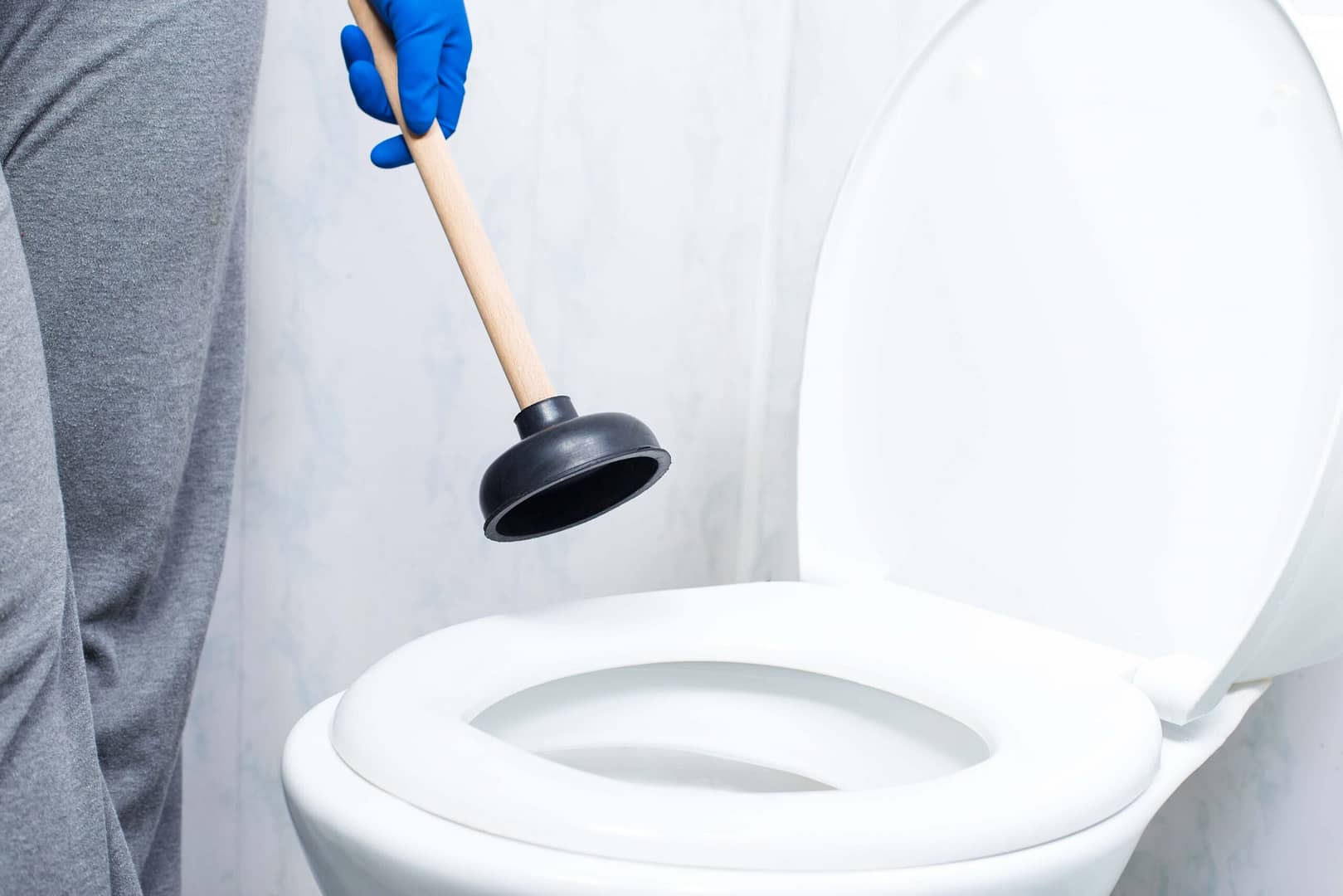It’s a horrifying situation but sooner or later it will happen to all of us; you go and do your business and then find that the toilet won’t flush. Not only is it potentially embarrassing and certainly unpleasant, it’s a potential sanitation risk.
Hopefully there’s not a line forming on the other side of the door!
There are a few possible causes when you find your toilet won’t flush but luckily, most of them are fairly straightforward fixes that you can undertake yourself if you have a basic understanding of how your toilet works.
Understanding Your Toilet’s Mechanics
Before we can go about fixing a toilet that won’t flush, it’s important to know how a toilet works in the first place.
At the most basic level, when you pull the chain/handle/button a tank of water is released down into the bowl and the force of this water pushes whatever you’ve left in there away into the sewers or septic tank.
Of course, there’s more to it than that and there’s a few of parts that can go wrong.
Most of the mechanical parts of your toilet are located in the tank. In there you’ll find the fill valve, float and the flush valve (also known as the “flapper”). They can take a few different forms, depending on which style of flush you have but mechanically, they’re all pretty similar.
When the tank is empty, the fill valve allows water in until the float rises enough to close it. When you push the button or pull the chain, the flapper lifts and allows the water to rush out into the bowl, flushing away whatever is in there.
Common Issues And How To Fix Them
Before we get into the nitty-gritty of possible reasons your toilet won’t flush, there’s one obvious thing to check first- is the supply valve on? If you find your toilet tank isn’t filling, that’s the first place to check.
If that doesn’t seem to be the issue, it’s time for a little troubleshooting.
Is it Clogged?
If you find that water leaves the tank and flows into the bowl but drains slowly or backs up, you’ve got a clog somewhere. This means something is blocking the waste pipe, either partially or fully.
If you find your toilet isn’t flushing well, there are a couple of steps you can take:
- Use a plunger: If you find that your pipes are clogged, a plunger might be enough to force whatever is blocking them loose. Make sure that you’re using a flanged plunger to get a good seal.
- Use a toilet auger: If you find that a plunger won’t cut it, you can try an auger. These are specialist versions of the “drain snake” that allow you to break up or pull out anything that has clogged your drain.
- Try the soapy water trick: If you don’t have a plunger or auger on hand sometimes filling a bucket with hot, soapy water will help. Simply pour as much soap and hot water as possible into the bowl, leave it to work its magic and then try flushing. It doesn’t always work but it can get you out of an embarrassing situation in a pinch.
If none of these work, it’s time to call in a professional as the blockage is likely further along the line than you’ll be able to reach without specialist tools.
Issues With The Flapper
When you find that your toilet won’t fully flush unless you hold down the handle or you find that it’s constantly running, the flapper might be the issue.
This is a small plug that blocks the hole at the bottom of your tank. When you pull the chain, push the button or depress the handle, it lifts the flapper, allowing water to rush out into the bowl.
Adjusting the chain
If you find you can only get a full flush while holding down the handle, the chances are good that your flapper’s chain is a little bit too long. When there’s too much slack in the chain, it can’t hold the flapper high enough to allow enough water down through the flush valve.
It’s a fairly straightforward fix:
- Locate the chain
- Detach it from the flapper
- Reattach it, making sure there’s only about 1/2” slack
- Test
- Trim the chain if there’s a chance of it getting caught
Fixing or Replacing the Flapper
If you find your toilet is constantly running, it’s likely your flapper isn’t making a tight seal over the flush valve. Here are few things to check:
- Is slack from the end of the chain getting between the flapper and the valve?
- Is the flapper aligned to fully cover the flush valve hole?
Of course, sometimes the rubber of your flapper is just old and perished. In this case, you’ll have to replace it. Often, it’s simpler to replace the whole assembly with a replacement kit.
Faulty Fill Valve
Another potential reason for a toilet that runs constantly is a faulty fill valve. Other potential symptoms include being slow to refill or a week flush.
The most likely culprit here is badly positioned float. If the float is set too high, the fill valve won’t shut off when the tank is full and water will pour down the overflow.
Another potential issue with the fill valve is leaking. It’s possible that the inlet isn’t properly connected or has been damaged.
Broken Handle or Chain
If you find your flushing mechanism is hanging loose or flapping, it’s usually a pretty easy fix.
The handle (or chain or button) of your toilet is connected to the flush mechanism, usually by an arm or a wire of some type. When you flush, this connection pulls the flapper up and water rushes out. Sometimes this comes loose.
To fix it, simply open your tank and reattach the connection.
Low Water Levels
Problems with water level are usually down to a badly set float on the fill valve. If the float is shutting the valve before the tank on your toilet is properly filled then you’ll find there isn’t enough force in your flush to clear the bowl.
To fix this issue, simply adjust your float so that the fill valve allows in more water.
Blocked Inlet Holes
Sometimes the problem isn’t in the tank at all but is actually part of the toilet bowl itself.
Limescale and debris can find their way into the inlet holes which allow water to flow from the tank to the bowl. If this is left for long enough it will eventually impede the flow of water and leave you with a toilet that won’t flush properly.
To fix it, simply ensure that you clean under the rim thoroughly and consider an in-tank treatment.
When To Call A Professional
Of course, sometimes things are beyond your skills and require a little professional help. If you can’t identify the problem or you’re not sure that you can fix it yourself a professional plumber is only ever a call away.
Not only will an expert eye be able to identify and fix any likely cause of your toilet not flushing, they’ll offer you peace of mind and insure that any warranties are kept in place and remain valid.
Preventative Measures
As they say, prevention is better than a cure and when it comes to toilets that’s certainly true.
Sometimes things break or block and there’s not a lot you can do about that but by being careful with your sanitary fittings, you can reduce the likelihood of clogs, blockages and breaks.
Keeping up with basic cleaning and maintenance tasks, such as ensuring that you clean not only the bowl but the whole toilet system will pay dividends. Keeping on top of these tasks will also help you to recognise a developing problem before it becomes a serious issue.
There are certain things which should never be flushed away:
- Wet wipes
- Sanitary towels and tampons
- Diapers
- Hair
- Cotton wool
- Cat litter
- Non-toilet tissue
- Food
- Dead pet fish
Any and all of these can contribute to clogs either in your own plumbing or, if enough people are doing it, the municipal sewers. If it’s not human waste or toilet paper, don’t flush it down.
Emergency Flushes
When you’ve got to go, you’ve got to go, even if your toilet won’t flush.
If you find yourself facing a call of nature while your toilet won’t flush properly you can often get by by filling a bucket and pouring it in the bowl.
This isn’t a great idea if you’re facing a clog but if the problem is in the tank this work around will help until you can put a proper fix in place.
When your toilet won’t flush properly you could be forgiven for panicking, but luckily, most issues are fairly easily fixed.

